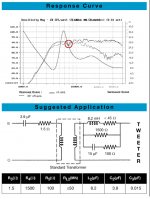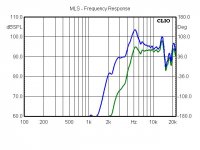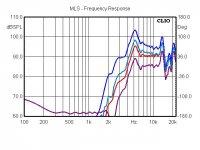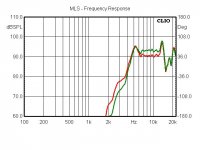5 kHz is only 0.322 octaves above 4 kHz. What kind of cross-over filter did you use? Something with a very high order, or with a notch at 4 kHz? Or does your tweeter have a lower resonance frequency?
Anyone with a pair of unwanted piezos they want to get rid of can toss them my way, pm me or some such if you are so inclined. Us ordinary failure genius composers whom the world reject can'[t be choosy.
All these small "bender disc" piezos have sharp, high-Q, mechanical resonances in the audio band. The bigger they are, and the thinner they are, the more nasty resonances you will find in the audio band.IIRC, the small element piezo of years back had a high Q resonance around 4KHz which made them sound rough.
Many years ago, I did some work on a motional-feedback subwoofer, using, I think, a 1" piezo disc for the accelerometer. Left unmounted, my memory is that it had a fundamental resonance at around 2 kHz.
I needed to raise that resonance frequency to improve the stability of my subwoofer feedback, so I made the piezo disc as stiff as possible by designing a mounting that solidly clamped the entire edge (perimeter) of the circular disk, leaving the centre free to bow slightly up and down, like a drum head.
Even fully supported like this, the first mechanical resonance was at around 5 kHz. You need four times the stiffness to double the resonant frequency, so going from 2 kHz to 5 kHz was actually a very good result - it indicates that the stiffness increased about 6.25 times by supporting the entire perimeter rigidly.
Once above 5 kHz, other mechanical resonances came thick and fast, as is typical for resonant systems. For my woofer application, these did not matter. But they would be a serious problem in a tweeter.
Add to that the fact that small, cheaply manufactured horns usually have a lot of their own peaks and dips in the frequency response, and you have a sonic disaster.
In a way, the piezo tweeter is the exact opposite of the electrostatic loudspeaker. In the speaker, you use a thin, large diaphragm made of a low density material with high mechanical losses and low "Q", and hope that the air itself adds additional damping. It works well enough to have many admirers.
In the piezo tweeter, by contrast, you use a stiff, small diaphragm made of a high-density material with low mechanical losses and high "Q" resonances in the audio band. Air has no hope of damping these. It works so badly that most piezo tweeters went off the market decades ago, and nowadays you only find them used in some fringe applications.
I remembered last night that I do have a couple of thrift-store boombox speakers that use piezo super-tweeters. There is no horn, and the crossover frequency is very high, not much more than the topmost audio octave (as verified by the minimal change in sound if I tape over the tweeter openings). At my current age, I don't hear anything above 15 kHz, so if the piezos make harsh distortion at 8 kHz, I don't hear it - the second harmonic of 8 kHz is already too high for these aging ears to respond to.
So there is a way to make piezo tweeters sound acceptable. Just cross over to them at such a high frequency that you can't actually hear them, and they will sound perfect! 😀
Incidentally, Digikey sells a variety of these piezo discs, in different sizes, having different resonance frequencies. The smallest one I can find has a piezo disc only about 8 mm in diameter (one third of an inch), laminated to a brass disc 12 mm in diameter (just under half an inch): https://www.digikey.ca/product-deta...cs-north-america/7BB-12-9/490-7709-ND/4358149 . Note that even this little piezo has a fundamental resonance at 6 kHz, which means there will be lots more resonances in the audio band.
Bigger ones are even worse (for tweeter use), as expected. Here is a bigger one (35mm diameter brass disc) with a 2.8 kHz first resonance: https://www.digikey.ca/product-deta...cs-north-america/7BB-35-3/490-7715-ND/4358155
Lower resonant frequencies are good for buzzer/beeper use (they sound less piercing). But, for a tweeter, there should be no resonances below 20 kHz, or at least 15 kHz. As you can see, that does not seem to be achievable with this piezo material, mainly because it is so dense. (Think heavy Cadillac going over speed bumps - lots of weight, low suspension resonance frequency.)
-Gnobuddy
Lots of failure geniuses here, why do you suppose we have nothing better to do than hang out on diyAudio. 😀...failure genius...
-Gnobuddy
1038a has resonance @4.5khz.
I used active lr 24db filter (-6db at xover point).
Lowering crossover made it spitty and really jump out at you buzzing.
I used active lr 24db filter (-6db at xover point).
Lowering crossover made it spitty and really jump out at you buzzing.
The ones that people recommend aren't cheapAs reference, for one of my first projects, I plan to put together some fairly inexpensive bookshelf speakers and I'm trying to determine if there would be any benefit to using piezo tweeters beyond simple cost.
So basically unless cost is a real issue avoid piezo. Is there any applications in which they excel, or are they essentially an outdated technology?
As people have said they excel at being a really cheap supertweeter when crossed very high. Complements cheap cone tweeters or mids well for inexpensive builds.
They're bot outdated so much as typically used for different applications. One of the most highly regarded super tweeters was the long-defunct Audax HD3P -a [fairly extreme] piezo variation. Not cheap either. Philosophically different from the pistonic mantra that largely dominates thinking around MC drivers (widebanders apart), but they are technically capable of good hi-fi performance if so designed.
Last edited:
I once tried KSN1142 down to 1K5 with a 5"x15" horn and notch filter. It also seemed to work "ok" with a 100 degree small Gollehon radial horn in conjunction with JBL D123. KSN1142 knockoffs seemed really terrible and the original could be rough depending upon load and xover. There's currently a smooth horn piezo without the long phase rod that's about $2 and not worth that much.
my Leson pair measured pretty nice - they've not been put into a system
my Leson pair measured pretty nice - they've not been put into a system
the mentiontioned Audax is a piezo polymer speaker, Pioneer, Gallo also used the polymer film but backed by foam rather than pressurizing with N2
the film is available in experimenters kits Piezo Electric Film Products
looks like Gallo is still using the polymer film Anthony Gallo Proprietary Technologies
the film is available in experimenters kits Piezo Electric Film Products
looks like Gallo is still using the polymer film Anthony Gallo Proprietary Technologies
I looked up the factory datasheet ( http://www.audax.com/archives/hd3p.pdf ). There is a fairly unpleasant notch in the frequency response at 8 kHz (see red circle in attached image). Off-axis response droops significantly above 10 kHz, meaning that the tweeter size is really too large to be a proper super-tweeter. Sensitivity is not exceptional at 90 dB@1W@1m - and even that requires a step-up transformer (!!) to increase the voltage to the tweeter, and a rather complex, bulky, and expensive crossover network (see attached image).One of the most highly regarded super tweeters was the long-defunct Audax HD3P
Perhaps this tweeter gained a good reputation a long time aggo because the on-axis frequency response extends well above 20 kHz, and that was a rare thing if you go back a few decades.
But the reality is that a tweeter sounds good or bad long before you get to 20 kHz. Really, it's the frequency response in the range from around 2 kHz to around 15 kHz that makes or breaks a tweeter.
These days it looks as though a $32 Tang Band ceramic dome tweeter outdoes the old Audax in every way: https://www.parts-express.com/pedocs/specs/264-865-tang-band-25-1719s-specifications-45762.pdf
There also seem to be several $15 dome tweeters sold by Parts Express that have smoother, wider frequency responses, and equal sensitivity without the need for bizarre, heavy, and expensive things like coupling transformers in the crossover network.
-Gnobuddy
Attachments
So basically unless cost is a real issue avoid piezo. Is there any applications in which they excel, or are they essentially an outdated technology?
They excel at being cheap indestructable playthings for an aspiring electronics tinkerer and loudspeaker designer. We've all been there, right fellas? So you should also have to go throught this phase!
My experience, too! Even in my childhood I recognize it. My father loved these LeSon piezo tweeters. So he put one in each Gradiente speaker box (with a 6" "fullrange" speaker)(a very cheap Japanese-IC-based sound system). To be fair I liked it for some time, and desired that all sound systems in the planet must have a piezo. But when I have ~11, I listened again other el-cheapo systems with paper tweeters and this time it makes me wonder about the piezo dirt thing and purity about magnetic tweeters (perhaps I "matured"?) Same complaint about crystal vs magnetic phono. The piezo have too much "extortion" (until my ~9 old I don't discriminate about extortion and distortion words; in Portuguese is similar also).This is exactly my experience as well. Utterly horrid, like being stabbed in the ears with knitting-needles. For me, quite literally, the piezo tweeters I've heard are unbearable - they cause so much discomfort that I cannot tolerate them.
The last one I encountered was built into a little Powerks PA-50 shoebox-sized mini P.A. system.( Amazon.com: Customer reviews: PowerWerks PW50 RMS Personal PA System 50W ). This product has tons of very positive reviews, as you can see, but when I got mine, I immediately found out that I could not bear the strident, harsh treble.
So I opened it up, and found it had a piezo tweeter. I disconnected it, and the sound was immediately much better - very muffled, of course, but at least it was bearable. Like an old AM radio.
I tried some of the proposed fixes for nasty piezo tweeter sound. I added a parallel resistor and high-pass cap - it sounded awful. I put in a series resistor - it sounded awful, and the level dropped way down. In the end, it became obvious that trying to get tolerable sound out of this piezo tweeter was the very definition of the term "wild goose chase".
Eventually I transplanted the electronics from the PA-50 onto the back of a vintage thift-store "Hi-Fi" speaker, with a woofer, an ancient paper cone tweeter, and a one-capacitor crossover network. The sound was much better, but still quite bad.
One of these days I'll transplant the electronics again, this time to a semi-decent speaker system.
And the original piezo tweeter? As far as I'm concerned, it should probably be shot with a silver bullet, drenched in holy water, and buried with a stake through its heart. It is that vile.
I do not know why some people seem completely unaffected by the sound of these piezo tweeters, and even give systems using them good reviews, while I find them as unbearable as razor-wire underwear. Clearly, there is something very, very different between the way those people's brain/ear connection works, and the way mine works, but that's all I know.
-Gnobuddy
Some time after I make some systems with piezo because of $$$ but as soon I have money I invested in a "magnetic" tweeter.
My mother HATED the piezo thing since the first one.
And some people really are insensitive to this. I have 2 cousins who love the most harsh "chip amps I've made", tweeters and/or recordings. I try several times to describe the sound for one of them and he says that don't perceive that; the other affirms to perceive that but just because that he love the HARSH ones!!! 😱
I have purchased one KSA1177 (CTS brand, NOS), for playing with. Firsts audible tests with direct connection, some suggested RC and so on showed a very harsh sound, low quality for sure, even with a sweet sounding mini triode amp! Even the most "eccentric" full ranges sounded far more sweet at high treble than this piezo thing.
So I will make freq response, CSD and HD measurements to try to discover the truth (when I find some time).
Good abservation about NOTCH. I have listened to inumerous speakers that have notches sounding far unpleasant, most than some speakers having PEAKS! So is a matter of Q and how this builds-up in the speaker element........ There is a fairly unpleasant notch in the frequency response at 8 kHz (see red circle in attached image).
...........
-Gnobuddy
For me the notion about peaks being more malign than notches are unfounded.
The ultimate high-pass filter for KSN-1005A
The ultimate high-pass filter:Sonce, you used term 'flat fr response' and 'piezo tweeter' twice, can you post some honest measurements?
Attachments
Measurements:Here`s a X-over schematic that's supposed to work fine with standard lemon squeeze piezos:
View attachment 629623
Dark blue: KSN-1005A
Light blue: high-pass with C=1.4 uF
Red: C=0.68 uF (maximum flat)
Purple: C=0.27 uF
This often-cited first-order high pass filter has rather limited use and mediocre performance. Better than without filter, of course.
Attachments
- Status
- Not open for further replies.
- Home
- Loudspeakers
- Multi-Way
- To piezo or not to piezo




